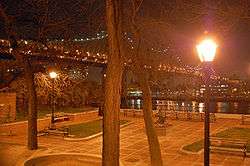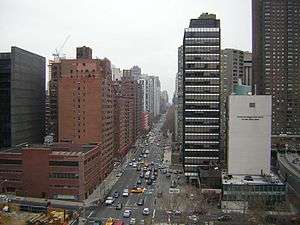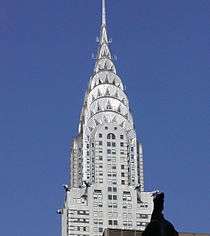York Avenue / Sutton Place
|
York Avenue from on top of the Queensboro Bridge | |
| Owner | City of New York |
|---|---|
| Maintained by | NYCDOT |
| Length | 2 mi[1] (3 km) |
| Location | Manhattan, New York City |
| South end | 53rd Street |
| North end | 90th Street |
| East |
Avenue B (between Houston and 14th Street) FDR Drive (between 14th and 79th St) East End Avenue (between 79th and 90th Street) |
| West | First Avenue |
| Construction | |
| Commissioned | March 1811 |

York Avenue, Sutton Place, and Pleasant Avenue are the names of a relatively short north-south thoroughfare in the Yorkville, Lenox Hill, and Sutton Place neighborhoods of the East Side of Manhattan, in New York City. York Avenue runs from 59th to 91st Streets through eastern Lenox Hill and Yorkville on the Upper East Side. Sutton Place and its southern extension runs through their namesake neighborhood along the East River and south of the Queensboro Bridge, with Sutton Place South running from 53rd to 57th Streets and Sutton Place from 57th to 59th Streets. The street is considered among the city's most affluent, and both portions are known for upscale apartments, much like the rest of the Upper East Side. Pleasant Avenue runs between 114th Street and 120th Street in East Harlem.
Addresses on York Avenue are continuous with that of Avenue A in the Alphabet City neighborhood, starting in the 1100 series and rising to the 1700 series. Addresses on Sutton Place vary.
The greater Sutton Place neighborhood, which sits north of the neighborhood of Turtle Bay, runs from 53rd Street to 59th Street and is bounded on the east by the East River and on the west by either First Avenue[2] or Second Avenue.[3] Sutton Square is the cul-de-sac at the end of East 58th Street, just east of Sutton Place; Riverview Terrace is a row of townhouses on a short private driveway that runs north from Sutton Square.
History
Early years
The street that became York Avenue and Sutton Place (and further north, Pleasant Avenue) was proposed as an addition to the Commissioners' Plan of 1811 for Manhattan, which designated 12 broad north-south avenues running the length of the island. The geography of Manhattan left a large area on the Upper East Side east of First Avenue without a major north-south thoroughfare, so Avenue A was added to compensate. Sutton Place, the name that applied to the whole street at the time, was originally one of several disconnected stretches of Avenue A built where space allowed, east of First Avenue.
In 1875, Effingham B. Sutton constructed a group of brownstones between 57th and 58th Streets.[4] The earliest source found by The New York Times using the term Sutton Place dates to 1883. At that time, the New York City Board of Aldermen approved a petition to change the name from "Avenue A" to "Sutton Place", covering the blocks between 57th and 60th Streets.[5][6] The block between 59th and 60th Streets is now considered a part of York Avenue.
Sutton Place first became fashionable around 1920, when several wealthy socialites, including Anne Harriman Vanderbilt and Anne Morgan, built townhouses on the eastern side of the street, overlooking the East River. Both townhouses were designed by Mott B. Schmidt, launching a career that included many houses for the wealthy.[7]) Very shortly thereafter, developers started to build grand co-operative apartment houses on Sutton Place and Sutton Place South, including several designed by Rosario Candela. Development came to an abrupt halt with the Great Depression, and the luxury apartment buildings on the lower part of Sutton Place South (below 57th Street) and the northernmost part of Sutton Place (adjacent to the Queensboro Bridge) were not developed until the 1940s and 1950s.
In 1928, a one-block section of Sutton Place north of 59th Street, and all of Avenue A north of that point, was renamed York Avenue to honor U.S. Army Sergeant Alvin York, who received the Medal of Honor for attacking a German machine gun nest during World War I's Meuse-Argonne Offensive.[6][8][9]
Park controversy

Sutton Place encompasses two public parks overlooking the East River, one at the end of 57th Street and another at the end of 53rd Street. The 57th Street park, named Sutton Place Park, is separated by an iron fence from the landscaped grounds behind One Sutton Place South, a neo-Georgian apartment building designed by Rosario Candela. The property behind One Sutton Place South was the subject of a dispute between the building's owners and the New York City Department of Parks and Recreation. Like the adjacent park, the rear garden at One Sutton Place South is, in fact, cantilevered over the FDR Drive, a busy parkway at Manhattan's eastern edge that is not visible from most of Sutton Place.
In 1939, city authorities took ownership of the property behind One Sutton Place South by condemnation in connection with the construction of the FDR Drive, then leased it back to the building. The building's lease for its backyard expired in 1990.[10][11] The co-op tried unsuccessfully to extend the lease, and later made prospective apartment-buyers review the legal status of the backyard and sign a confidentiality agreement.[12] In June 2007, the co-op sued the city in an attempt the keep the land,[12] and on November 1, 2011, the co-op and the city reached an agreement in which the co-op ended its ownership claim and each side would contribute $1 million toward the creation of a public park on the land.[13]
Notable residents
Residents of Sutton Place include writer Ève Curie, architect I. M. Pei, designer Kenneth Cole, and actress Sigourney Weaver. Former residents include Consuelo Vanderbilt Balsan, C.Z. Guest, Peter Lawford & Patricia Kennedy Lawford, Lillian Gish, Aristotle Onassis, Freddie Mercury, Michael Jackson, Bill Blass, Bobby Short, Percy Sutton, Irene Hayes, Elsie de Wolfe, Joan Crawford, Raj Rajaratnam, Richard Jenrette, Marilyn Monroe and her then husband Arthur Miller, Mildred Natwick, Maureen O'Hara, UN Secretary General Ban Ki-moon, and former New York Governor Mario Cuomo.
Points of interest
One Sutton Place North, a townhouse at the northeast corner of Sutton Place (dead end) and East 57th Street, was built as a residence for Anne Harriman Vanderbilt, widow of William K. Vanderbilt. Next door, the official residence of the Secretary-General of the United Nations is a four-story brick townhouse that was built in 1921 for Anne Morgan, daughter of financier J.P. Morgan, and donated as a gift to the United Nations in 1972.[14] The Secretary's home is 0.6 miles (0.97 km) from the UN Headquarters. These townhouses have a park at the rear with FDR Drive running below I(Sutton Place Tunnel) along the East River.
The auction house Sotheby's is headquartered on York Avenue.[15]
In popular culture
- 1935/37 – Sutton Place at East 53rd Street is the Dead End of the play and movie of that name, which began the movie careers of the Dead End Kids.
- 1936 – The lyric for Rodgers and Hart's On Your Toes mentions Sutton Place as a desirable address: "This motto applies to folks who dwell in Richmond Hill or New Rochelle, in Chelsea or In Sutton Place."
- 1936 – The movie My Man Godfrey starring William Powell was about a hobo in a hobo jungle that once was adjacent the Queensboro Bridge and "Sutton Place" is mentioned frequently in the movie as where Godfrey the butler was found and hired.
- 1947 – In John Cheever's short story "The Enormous Radio", the main characters, Jim and Irene Wescott, live in an apartment in the Sutton Place neighborhood.
- 1948 – 1 Sutton Place North is the home of Alison Courtland (Claudette Colbert) and her husband Richard (Don Ameche) in Douglas Sirk's film noir "Sleep, My Love".
- 1951 – Sutton Place is mentioned in J. D. Salinger's novel Catcher in the Rye as the location of a "swanky" apartment.
- 1953 – 36 Sutton Place South was an exterior location for the film How to Marry a Millionaire starring Marilyn Monroe.[16]
- 1958 – Sutton Place is featured in "Lady Bug, Lady Bug" episode of the TV show Naked City.
- 1960 – Sutton Place is featured in the film Satan in High Heels.
- 1966 – The Avenue A Estate on Sutton Place was the site of the "East End Hotel," the home of Ann Marie in That Girl.
- 1970 – In an article in New York magazine, Tom Wolfe mentions "the famous Mrs. C--------, one of New York’s richest widows, who has a 10-room duplex on Sutton Place, the good part of Sutton Place as opposed to the Miami Beach-looking part". The article was later reprinted in the book Radical Chic & Mau-Mauing the Flak Catchers.
- 1973 – Sutton Place is featured in Larry Cohen's film Black Caesar.
- 1976 – Sutton Place South's wealthy residents are mentioned in Martin Scorsese's film Taxi Driver.
- 1979 – Sutton Place's park appears in Woody Allen's film Manhattan.
- 1983 – Sutton Square, the cul-de-sac at the end of East 58th Street just east of Sutton Place, was depicted as the home of the lead character (a wealthy playwright) in the Dudley Moore film Romantic Comedy.
- 1983 – Scarface had a scene in which Tony Montana (Al Pacino) was on the telephone in the now-defunct 60th Street Heliport, now used as a dog run.
- 1984 – On his album New Sensations, Lou Reed, in the song "High in the City", sings: "Let's not walk down Sutton Place; you know everybody there's got Akitas."
- 1986 – In the film Legal Eagles, the villain, Victor Taft (Terence Stamp), resided on Sutton Place.
- 1987 – In Oliver Stone's film Wall Street, an excited broker (Sylvia Miles) offers to show Bud Fox (Charlie Sheen) some apartments on Sutton Place once she realizes how wealthy he is.
- 2000 – In the film Almost Famous, Patrick Fugit's character is seen sprinting down Sutton Place.
- 2007 – 50 Sutton Place South was one of the buildings used to film American Gangster.
- 2008 – Sutton Place is mentioned in season 3, episode 2 of the TV series Mad Men. Set in 1963, it's where the new British CFO finds an apartment when he arrives in New York to run the advertising agency.
- 2008 – Sutton Place is the location of the home of the main character in Mary Higgins Clark's novel Where Are You Now?. Clark owns an apartment in the neighborhood, and in several books her characters occasionally dine at Neary's, an actual Irish bar and restaurant located on East 57th Street between First and Second Avenues.
- 2013 – Vampire Weekend's song "Hudson", on their album Modern Vampires of the City, contains the line "But I was born on Sutton Place".
See also
- 2006 New York City plane crash, a crash just off of York Avenue/Sutton Place on October 11, 2006
- Beekman Place
References
- ↑ Google (December 1, 2015). "York Avenue / Sutton Place" (Map). Google Maps. Google. Retrieved December 1, 2015.
- ↑ Wilson, Claire (June 15, 2003). "If You're Thinking of Living In/Sutton Place; Prestigious Address With Villagelike Feel". The New York Times. Retrieved November 14, 2014.
...Sutton Place, a tidy and somewhat out-of-the-way Manhattan enclave that runs from 53rd to 59th Streets between First Avenue and the East River.
- ↑ Johnston, Laurie (May 27, 1984). "If You're Thinking of Living in Sutton Place". The New York Times. Retrieved November 14, 2014.
...the name [Sutton Place] reflects its glow south to 53d Street, west to Second Avenue and even a bit farther west on 57th Street.
- ↑ Sutton Place Park history, NYC Parks website. Retrieved 2015-01-06.
- ↑ Senft, Bret. "If You're Thinking of Living In/Sutton Place; A Riverside Enclave for the Well-to-Do", The New York Times, June 12, 1994. Accessed December 27, 2007.
- 1 2 Gray, Christopher (September 21, 2003). "Streetscapes/Sutton Place, Sutton Place South and One Sutton Place North; A Prestigious Enclave With a Name in Question". The New York Times. Retrieved December 27, 2007.
- ↑ Hewitt, Mark Alan. "About Mott Schmidt: Beginnings and Sutton Place". The Architecture of Mott B. Schmidt. MottSchmidt.com. Retrieved September 8, 2012.
- ↑ Pollak, Michael. "F. Y. I.", The New York Times, August 7, 2005. Accessed October 16, 2007. "In 1928, Sutton Place from 59th to 60th Street, and Avenue A north of 60th, were renamed York Avenue in honor of Sgt. Alvin C. York (1887-1964), a World War I hero from Tennessee and a recipient of the Medal of Honor."
- ↑ During his on October 8, 1918, attack, York captured four German officers and 128 men and several guns. "Medal of Honor Recipients - World War I". United States Army Center of Military History.
- ↑ Bagli, Charles V. "In Sutton Place's Backyard, Private Oasis on Public Land", The New York Times, December 31, 2003
- ↑ "Sutton Place Private Lawn Going to the Masses", Curbed.com, December 7, 2004
- 1 2 Bagli, Charles V., "A Co-op on Sutton Place Sues to Keep Its Backyard", The New York Times, June 19, 2007. Accessed December 27, 2007.
- ↑ Flegenheimer, Matt, "Co-op Ends Fight With City Over Its East Side Backyard", The New York Times, November 1, 2011. Accessed November 4, 2011.
- ↑ Teltsch, Kathleen. "Town House Offered to U. N.", The New York Times, July 15, 1972. Accessed December 27, 2007.
- ↑ "Sothebys Contact Info". Business Insider. Retrieved 2013-05-22.
- ↑ Alleman, Richard (1988), The Movie Lover's Guide to New York, New York: Harper & Row, ISBN 0060960809, p.117
External links
 Media related to York Avenue (Manhattan) at Wikimedia Commons
Media related to York Avenue (Manhattan) at Wikimedia Commons Media related to Sutton Place at Wikimedia Commons
Media related to Sutton Place at Wikimedia Commons

